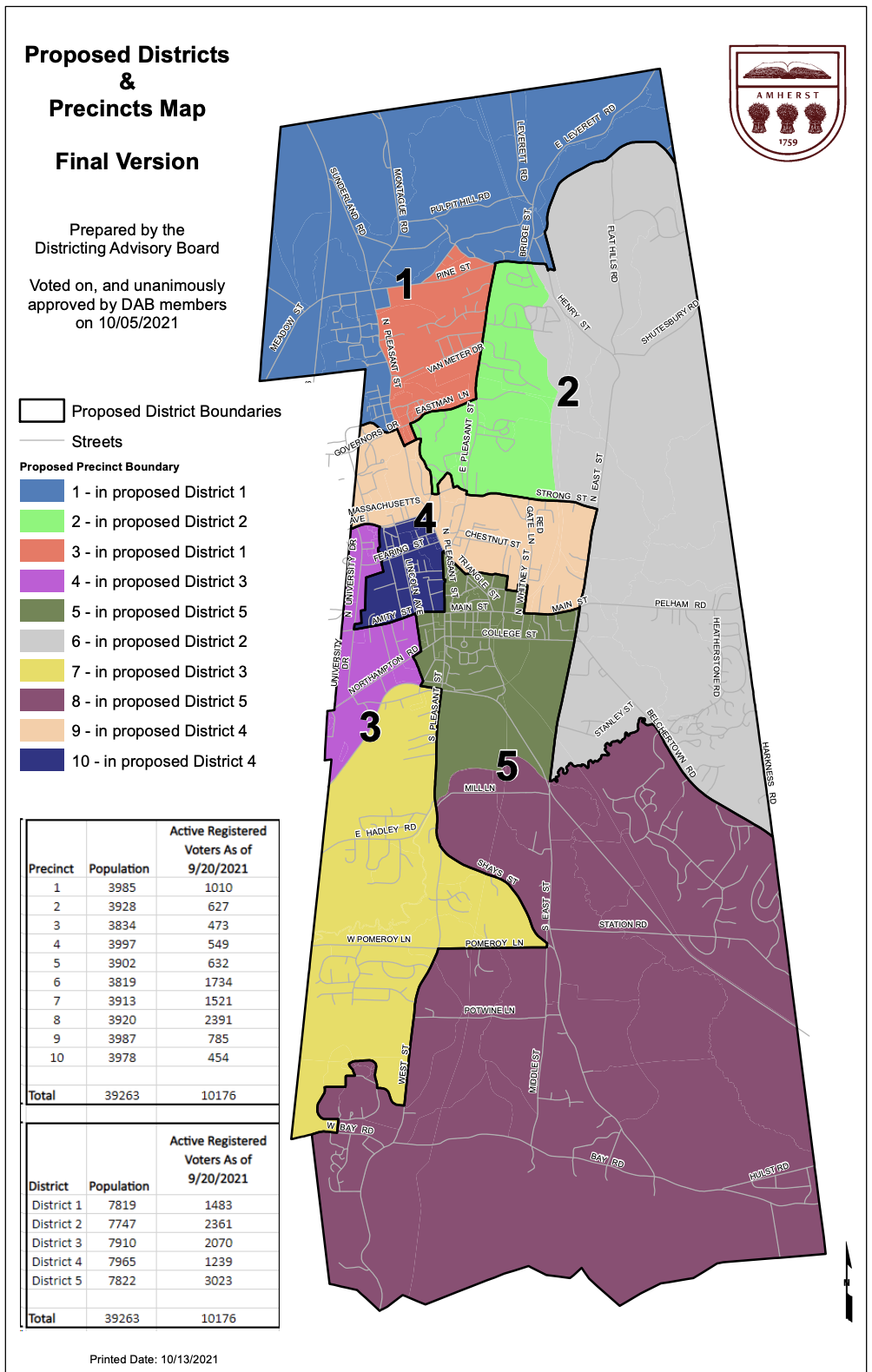Proposed Redistricting Plan Reassigns Precincts and Districts

Final proposed redistricting map for Amherst from the Districting Advisory Board. Photo: amherstma.gov
Report From The District 5 Meeting, October 13, 2021
All municipalities in Massachusetts are required to present a redistricting plan for voting precincts, using 2020 census data, to the state by the end of October. Although for most municipalities, the state does the redistricting, because of special circumstances in Amherst, in which the most densely populated areas near UMass have relatively few active voters who registered in Amherst rather than their hometowns, Amherst has always done its own redistricting.
Twenty-one residents attended this Zoom presentation, including Councilors Darcy DuMont and Shalini Bahl-Milne (District 5) and Alisa Brewer and Andy Steinberg (At large). Districting Advisory Board (DAB) member Peggy Shannon shared the board’s final report (October 13), which will be presented to the full council at its October 18 meeting and can be viewed here.
Background
Shannon explained that one’s precinct specifies where one votes, while the districts determine which elected officials represent you in local matters. Amherst currently has 10 precincts. Five districts are specified in the Home Rule Charter. The state stipulates that there can be no more than 4,000 residents in any precinct. It was thought that Amherst would need more precincts because of a slight increase in population, but the 2020 census listed the population at 39,263, which is 1,444 more than in 2010 but less than the 40,000 that would mandate additional voting precincts. And, because the charter specifies exactly five districts, keeping each district equal to the others would probably necessitate 15 precincts. More precincts would mean more polling places and an increased expense.
Creating New Precincts And Districts
The DAB aimed to draw new precinct lines which would keep the 10 precincts and evenly distribute not only the number of residents but the number of active voters. In the current situation, South Amherst (District 5, Precincts 7 and 8) is the most sparsely populated area, but has the most active voters, while the area around UMass has the densest population but the fewest active voters. With the construction of the Commonwealth Honors College at UMass since the 2010 census, the population of Precinct 10 showed the greatest increase in voters to 5,446. Precinct 8 had the fewest residents at 3,142.
The DAB was composed of representatives from every district. It was supposed to have 10 members, but membership varied from seven to nine. Ordinarily, census data would be available in the spring, but because of the pandemic and other factors, the committee did not receive the census information until August.
The new map gives minority groups a larger share of the active voters in their district.
Besides requiring that all precincts have fewer than 4,000 residents, the state mandates that variation between precincts’ populations must be within 5%, so no precinct can have fewer than 3,740 residents. In addition, precincts must be contiguous and “regularly” shaped. Minority populations cannot be diluted, according to state guidelines. In addition, the DAB tried to distribute active voters evenly, to keep neighborhoods together, and to try to retain current precincts.
To achieve these goals, the DAB developed over 20 maps and decided on the one depicted here..
In this map, District 1 has Precincts 1 and 3, District 2 has Precincts 2 and 6, District 3 has Precincts 4 and 7, District 4 has Precincts 9 and 10, and District 5 has Precincts 5 and 8. Precinct lines have been altered slightly to keep each one under 4,000 residents. Eighty-one percent of residents remain in the same precinct, but only 61% remain in the same district.
The area with the largest BIPOC population, off East Hadley Road, was previously in District 5, which diluted the power of their vote because it had the largest number of active voters. The new map puts Precinct 7 with Precinct 4, which is near downtown. The new map gives minority groups a larger share of the active voters in their district.
If approved by the state, the new voting maps will go into effect for the state elections in fall 2022, although current town districts will remain in effect until the fall of 2023, when there will be new elections for town council and certain other local boards and commissions.

One clarification regarding the composition of the DAB as described in the Home Rule Charter.
The DAB is supposed to have 9 voting members — including up to 2 members per district. The DAB also has 3 non-voting members: the Town Clerk, a member from the Board of Registrars, and a IT staff person for the Town of Amherst.
I’m a member of the DAB representing District 3.